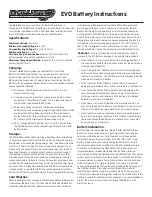
4
USER GUIDE
(Read through the instructions before use):
1.
Read the safety notes and take the stated precautions.
2.
Connect the charger’s mains plug to a power socket. The lamp
on the front of the charger shine.
3.
Connect the charger’s red cable clamp to the battery’s positive
terminal post (+), and the black cable clamp to the battery’s
negative terminal post (-). When the charger is correctly
connected, the yellow LED (green LED during 13.7 V Supply)
flashes for around 3 seconds. If the cables are incorrectly con-
nected, the red LED lights to indicate a fault. If that is the case,
check the connection and adjust accordingly.
4.
Select the correct mode (Ah and AGM/GEL or standard battery,
see below)* by pressing the button repeatedly until the LED
flashes against the desired battery size and type, or at the “13.7 V
Supply” if this function is desired.
5.
Charging/power supply will begin automatically after 3 sec-
onds, when the LED will stop flashing and will change to a
constant yellow. At the same time, the lamp on the front of the
charger will go out.
6.
The LED will be a constant yellow until the charge is complete,
when the LED changes from yellow to green. In the “13.7 V
Supply” mode, the green lamp illuminates while the function is
connected.
7.
Following completion of the charge, the charger cables can
either be removed from the terminals, or may remain in place
for continual maintenance. New periods of charging will then
take place automatically at regular intervals.
8.
Charging/power supply may be interrupted at any time, by
unplugging the charger’s mains cable from the power socket.
9.
Following completion of the charge. Unplug the power cables,
remove the cable clamps from the battery terminals and store
the charger in its original storage box for safe-keeping when
not in use.
*The battery size (Ah) is usually printed on the battery itself.
Batteries are either of type AGM/GEL or standard. AGM/GEL
are valve-regulated batteries, where the electrolyte (the acid)
is absorbed or is in gel form, and are often clearly marked
AGM or GEL. Other batteries are standard batteries.




























